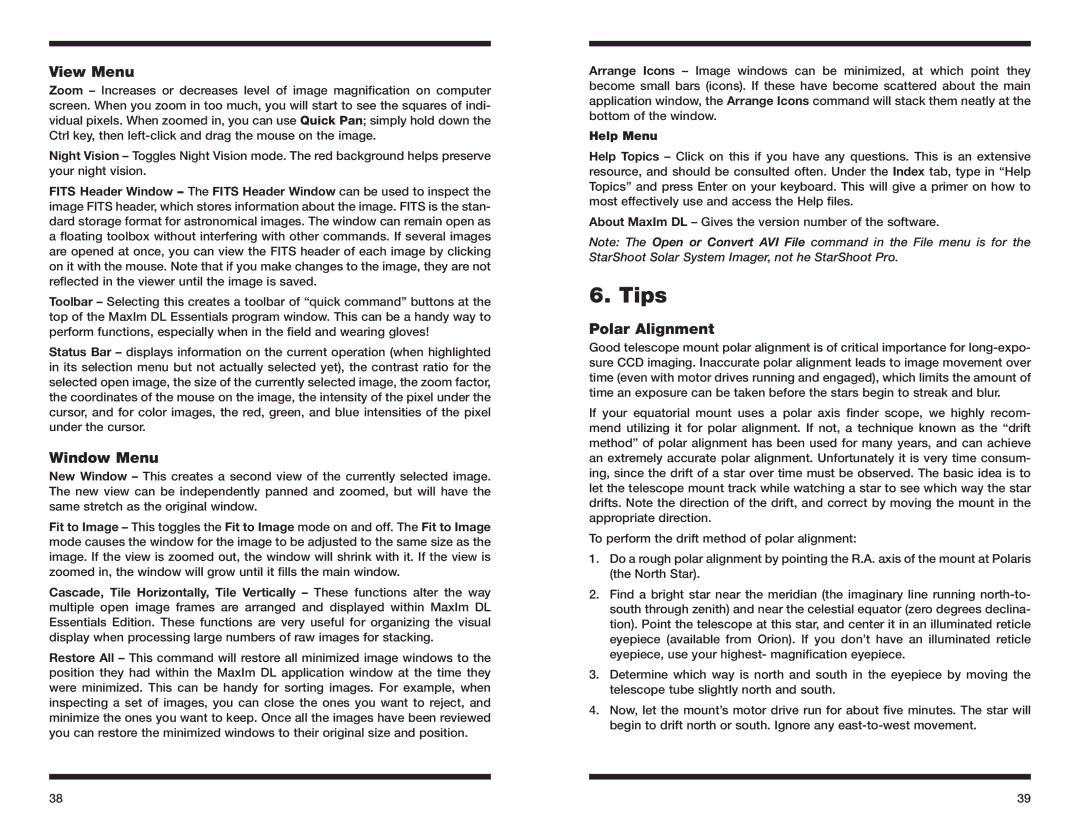
View Menu
Zoom – Increases or decreases level of image magnification on computer screen. When you zoom in too much, you will start to see the squares of indi- vidual pixels. When zoomed in, you can use Quick Pan; simply hold down the Ctrl key, then
Night Vision – Toggles Night Vision mode. The red background helps preserve your night vision.
FITS Header Window – The FITS Header Window can be used to inspect the image FITS header, which stores information about the image. FITS is the stan- dard storage format for astronomical images. The window can remain open as a floating toolbox without interfering with other commands. If several images are opened at once, you can view the FITS header of each image by clicking on it with the mouse. Note that if you make changes to the image, they are not reflected in the viewer until the image is saved.
Toolbar – Selecting this creates a toolbar of “quick command” buttons at the top of the MaxIm DL Essentials program window. This can be a handy way to perform functions, especially when in the field and wearing gloves!
Status Bar – displays information on the current operation (when highlighted in its selection menu but not actually selected yet), the contrast ratio for the selected open image, the size of the currently selected image, the zoom factor, the coordinates of the mouse on the image, the intensity of the pixel under the cursor, and for color images, the red, green, and blue intensities of the pixel under the cursor.
Window Menu
New Window – This creates a second view of the currently selected image. The new view can be independently panned and zoomed, but will have the same stretch as the original window.
Fit to Image – This toggles the Fit to Image mode on and off. The Fit to Image mode causes the window for the image to be adjusted to the same size as the image. If the view is zoomed out, the window will shrink with it. If the view is zoomed in, the window will grow until it fills the main window.
Cascade, Tile Horizontally, Tile Vertically – These functions alter the way multiple open image frames are arranged and displayed within MaxIm DL Essentials Edition. These functions are very useful for organizing the visual display when processing large numbers of raw images for stacking.
Restore All – This command will restore all minimized image windows to the position they had within the MaxIm DL application window at the time they were minimized. This can be handy for sorting images. For example, when inspecting a set of images, you can close the ones you want to reject, and minimize the ones you want to keep. Once all the images have been reviewed you can restore the minimized windows to their original size and position.
Arrange Icons – Image windows can be minimized, at which point they become small bars (icons). If these have become scattered about the main application window, the Arrange Icons command will stack them neatly at the bottom of the window.
Help Menu
Help Topics – Click on this if you have any questions. This is an extensive resource, and should be consulted often. Under the Index tab, type in “Help Topics” and press Enter on your keyboard. This will give a primer on how to most effectively use and access the Help files.
About MaxIm DL – Gives the version number of the software.
Note: The Open or Convert AVI File command in the File menu is for the StarShoot Solar System Imager, not he StarShoot Pro.
6. Tips
Polar Alignment
Good telescope mount polar alignment is of critical importance for
If your equatorial mount uses a polar axis finder scope, we highly recom- mend utilizing it for polar alignment. If not, a technique known as the “drift method” of polar alignment has been used for many years, and can achieve an extremely accurate polar alignment. Unfortunately it is very time consum- ing, since the drift of a star over time must be observed. The basic idea is to let the telescope mount track while watching a star to see which way the star drifts. Note the direction of the drift, and correct by moving the mount in the appropriate direction.
To perform the drift method of polar alignment:
1.Do a rough polar alignment by pointing the R.A. axis of the mount at Polaris (the North Star).
2.Find a bright star near the meridian (the imaginary line running
3.Determine which way is north and south in the eyepiece by moving the telescope tube slightly north and south.
4.Now, let the mount’s motor drive run for about five minutes. The star will begin to drift north or south. Ignore any
38 | 39 |
